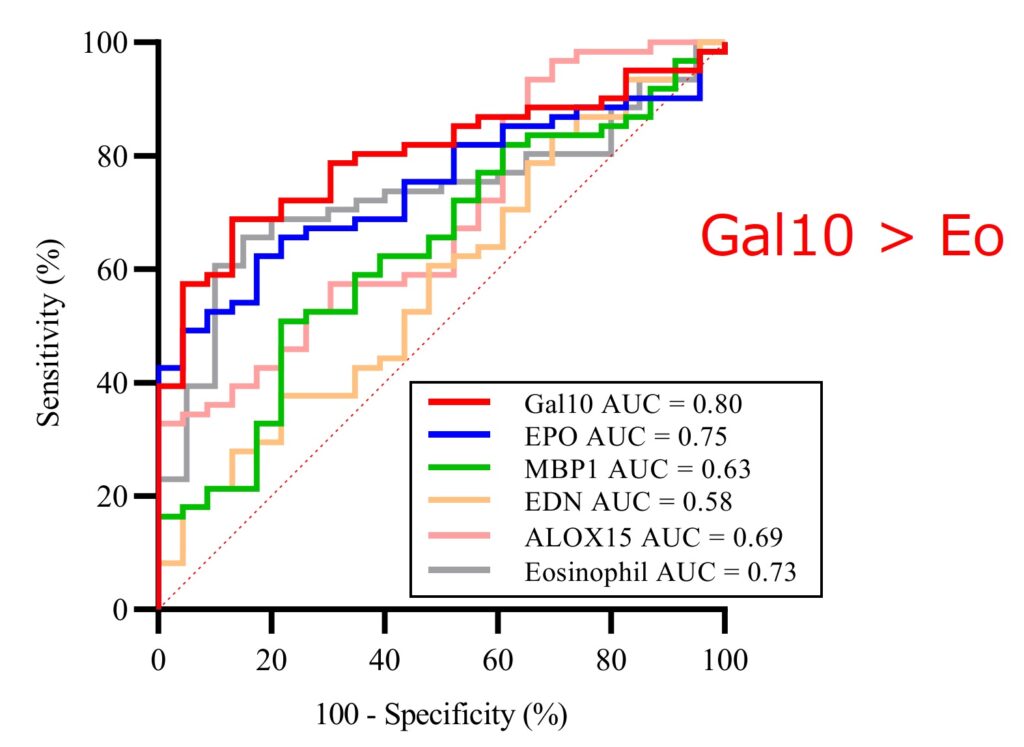Advantages
- Superior diagnostic performance compared to peripheral blood eosinophil count, widely recognized as the gold standard for asthma diagnosis.
- Biomarker closely aligned with asthma pathology, promising for diagnosing and predicting asthma severity, as well as evaluating the efficacy of therapeutic interventions.
Technology Overview & Background
The prevalence of asthma is significant, with over 1 million patients undergoing continuous treatment in Japan and approximately 300 million worldwide. Asthma presents a complex clinical profile characterized by airway inflammation, hyperresponsiveness, and reversible airflow limitation. Despite the advent of molecularly targeted biologic agents, treatment options have expanded, yet clinical practice still relies on limited biomarkers such as blood and sputum eosinophil counts, exhaled nitric oxide concentration, and serum IgE levels. These traditional biomarkers fall short in adequately classifying asthma phenotypes and tailoring treatment accordingly.
The inventors have long studied the search for biomarkers in exosomes. Noting that more than 80% of patients with severe asthma have an eosinophilic phenotype, they searched for BMs that strongly reflect the pathophysiology of eosinophilic asthma. As a result, galectin-10 derived from serum exosomes was found as a BM candidate. Our inventors have diligently explored exosomes as a potential source of biomarkers. Focusing that over 80% of severe asthma cases exhibit an eosinophilic phenotype, they sought biomarkers reflecting the underlying pathophysiology. Consequently, galectin-10 derived from serum exosomes emerged as a promising candidate. Galectin-10, a prominent protein is mainly expressed in eosinophils and it also found in Charcot-Leyden crystals formed during eosinophil cell death (etosis), holds close relevance to eosinophilic pathology and type 2 inflammation promotion. Notably, galectin-10 demonstrated high expression levels in the lung and bronchiolar tissues of eosinophilic asthmatic patients.
Additionally, galectin-10 proved to be a valuable marker for eosinophilic sinusitis, a common comorbidity of severe asthma, exhibiting correlation with disease presence, severity, and progression.
Data
Publications
Yoshimura, H.et al., Journal of Allergy and Clinical Immunology,2024
[DOI] https://doi.org/10.1016/j.jaci.2023.12.030.
Patents
Principal Investigator & Academic Institution
Yoshito TAKEDA(Associate Professor, Department of Respiratory Medicine and Clinical Immunology, The University of Osaka Graduate School of Medicine)
Expectations
TECH MANAGE seeks collaboration with diagnostic or therapeutic companies interested in utilizing or further developing this innovation for asthma diagnosis, therapeutic efficacy assessment, companion diagnostics, etc. We welcome inquiries and can facilitate discussions with the principal investigator of this groundbreaking invention.
Please do not hesitate to reach out with any inquiries.
Project.TT-04880



